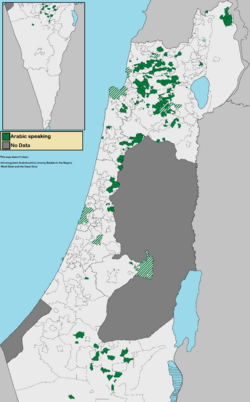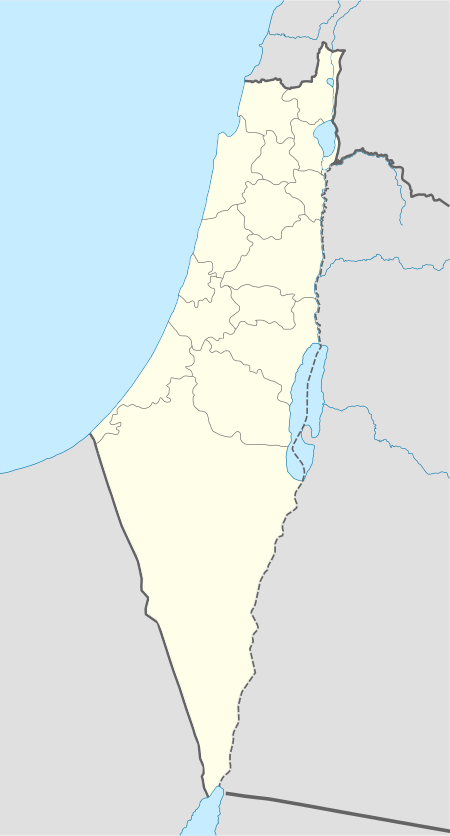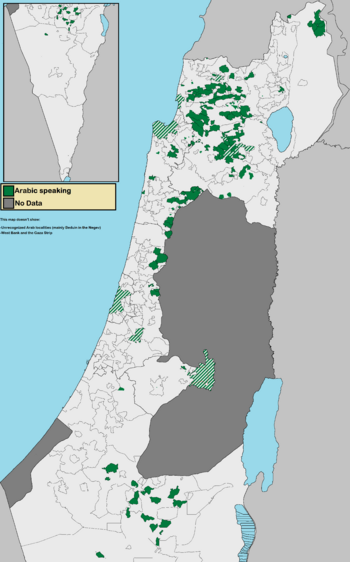البلدات العربية في إسرائيل
البلدات العربية في إسرائيل، تتضمن جميع المراكز السكنية التي يشكل العرب فيها 50% أو أكثر. القدس الشرقية ومرتفعات الجولان غير معترف بها دولياً كجزء من إسرائيل لكنها مضمنة في القائمة.
بحسب تعداد المكتب المركزي للإحصاء عام 2010، "يعيش السكان العرب في 134 بلدة وقرية. ويعيش حوالي 44% منهم في المدن (مقارنة بـ 81% من السكان اليهود)؛ يعيش 48% في قرى ذات مجالس محلية (مقارنة بـ 9% من السكان اليهود). ويعيش 4% من المواطنين العرب في قرى صغيرة ذات مجالس إقليمية، بينما يعيش الباقون في قرى غير معترف بها (النسبة أعلى بكثير، 31 بالمائة في النقب)".[1] يتوزع السكان العرب في إسرائيل في خمس مناطق رئيسية: الجليل (54.6% من إجمالي العرب)، المثلث (23.5% من إجمالي العرب)، مرتفعات الجولان، القدس الشرقية، وشمال النقب (13.5% من إجمالي العرب).[1] يعيش حوالي 8.4% من عرب إسرائيل رسميًا في مدن يهودية عربية مختلطة (باستثناء السكان العرب في القدس الشرقية)، بما في ذلك حيفا، اللد، الرملة، تل أبيب-يافا، عكا، الناصرة العليا، ومعالوت ترشيحا.[2]
عام 2021، كان هناك 163 تجمعًا سكانيًا جميع سكانها العرب، 69 منها مجالس محلية عربية و12 مجالس مدن عربية.[3][4] بحسب معهد الديمقراطية الإسرائيلي يعيش حوالي 49.1% من عرب إسرائيل في المجالس المحلية العربية، ويعيش 30.9% في مجالس المدينة العربية و8.3% يعيشون في المدن المختلطة رسميًا.[3] يعيش 5.5% أخرى من المواطنين العرب في 47 تجمعًا صغيرًا مدمجًا في المجالس الإقليمية، ويعيش 4.2% في قرى غير معترف بها (ومعظمها في النقب)، و1.8% يعيشون في مدن ذات أغلبية يهودية (بما في ذلك القدس الغربية).[3] The percentages do not including East Jerusalem Arab residents.[3]
في عكا تبلغ نسبة سكان الأقلية العربية 30.1%، بينما تبلغ نسبة العرب في مدينتها القديمة 95%. بينما يشكل العرب 11% من إجمالي سكان حيفا، فإنهم يشكلون 70% من سكان حيفا السفلى.[5] عام 2011، يبلغ عدد السكان العرب في يافا 30.3%، واللد 24.3% عرب، بينما تبلغ نسبة العرب في الرملة 22.2%.[6] في عام 2015، كان 23% من سكان الناصرة العليا من العرب.[7]
بحسب هآرتس عام 2015، يُعتقد أن 16.000 عربي فقط يعيشون في 16 منطقة لم يتم تعريفها رسميًا على أنها مدن مختلطة، أو في الأحياء اليهودية في حيفا والقدس وتل أبيب.[8] بحسب لمكتب الإحصاء المركزي الإسرائيلي، تعيش نسبة كبيرة من العرب في المدن ذات الأغلبية اليهودية مثل إيلات (5% عرب)، كرميئيل (4%)، كريات شمونة (3%)، عراد (3%)، بئر السبع (3%)، نهاريا (2%)، صفد (2%) وطبريا (2%)[9]
المنطقة الوسطى ومنطقة حيفا
المثلث الجنوبي
Estimated population figures for 2019 are listed below.[10]
- Jaljulia: 10,148
- Kafr Bara: 3,678
- Kafr Qasim: 23,823
- Qalansawe: 23,143
- Tayibe: 43,957
- Tira: 26,552
- Zemer:[أ] 7,094
المثلث الشمالي
- Ar'ara[ب] 25,245
- Baqa al-Gharbiyye 29,950
- al-Arian 191
- Basma[ت] 10,010
- Jatt 12,100
- Kafr Qara 19,018
- Ma'ale Iron[ث] 15,065
- Meiser 2,017
- Umm al-Fahm 56,109
- Umm al-Qutuf 1,117
اللد
الرملة
حيفا ومنطقة الكرمل
- Wadi Nisnas, Halisa, Kababir and Abbas (Haifa neighborhoods)†[13]
- Daliyat al-Karmel☆
- Ein Hawd
- Fureidis
- Ibtin
- Isfiya☆†
- Jisr az-Zarqa
- Khawaled
† Significant presence of Christian population
☆ Significant presence of Druze population
منطقة تل أبيب
18,500 Arabs live in the Tel Aviv District, which has a total population of 1,318,300.[14] 16,000 of them live in Jaffa, where they make up around a third of the population. In 2019 the population of Tel Aviv-Jaffa was 89.9% Jewish, and 4.5% Arabs; among Arabs 82.8% were Muslims, 16.4% were Christians, and 0.8% were Druze.[15]
منطقة القدس
القدس الغربية
- Abu Ghosh 7,698
- Beit Jimal
- Ein Naqquba 3,505
- Ein Rafa 1,250
القدس الشرقية
- Beit Hanina (al-Jadid or Eastern portion)†
- Beit Safafa
- Jabel Mukaber
- Old City (Armenian, Muslim & Christian Quarters)†
- Ras al-Amud
- Sheikh Jarrah
- Shuafat
- Silwan
- Sur Baher
- At-Tur
- Umm Tuba
- Wadi al-Joz
- al-Walaja
† Significant presence of Christian population
المنطقة الجنوبية
المنطقة الشمالية
- أبو سنان☆†
- Arab al-Aramshe
- Arab al-Subeih
- Arab al-Na'im
- Arraba†
- Basmat Tab'un
- Beit Jann☆
- Bi'ina†
- Bir al-Maksur
- Bu'eine Nujeidat[ج]
- Buqei'a☆†
- Daburiyya
- Ed Dahi
- Deir al-Asad
- Deir Hanna†
- Dmeide
- Eilabun†
- Ein al-Asad☆
- Ein Mahil
- Fassuta†
- Hamaam
- Hamdon
- Hurfeish☆†
- Hussniyya
- I'billin†
- Iksal
- Ilut
- Jadeidi-Makr[ح]
- Jish†
- Julis☆
- Ka'abiyye-Tabbash-Hajajre[خ]
- Kabul
- Kafr Kanna†
- Kafr Manda
- Kafr Misr
- Kafr Yasif†☆
- Kamanneh[د]
- Kaukab Abu al-Hija
- Kfar Kama[ذ]
- Kisra-Sumei☆†[ر]
- Maghar☆†
- Majd al-Krum
- Manshiya Zabda
- Mashhad
- Mazra'a†
- Mi'ilya†
- Muqeible†
- Nahf
- Na'ura
- Nazareth†
- Nein
- Rameh†☆
- Ras al-Ein†
- Rehaniya[ذ]
- Reineh†
- Rumana
- Rumat al-Heib
- Sajur☆
- Sakhnin†
- Sallama
- Sandala
- Sha'ab
- Shefa-'Amr†☆
- Sheikh Danun
- Shibli–Umm al-Ghanam[ز]
- Sulam
- Suweid Hamira
- Tarshiha†[س]
- Tamra City, Akka Subdistrict
- Tamra Village, Jezreel sub-district
- Tuba-Zangariyye[ش]
- Tur'an†
- Uzeir
- Yafa an-Naseriyye†
- Yanuh-Jat☆[ص]
- Yarka☆
- Zarzir
† Significant presence of Christian population († - Christian majority)
☆ Significant presence of Druze population (☆ - Druze majority)
مرتفعات الجولان
- Buq'ata☆
- Ein Qiniyye☆†
- Ghajar
- مجدل شمس☆†
- Mas'ade☆
☆ Significant presence of Druze population (☆ - Druze majority)
† Significant presence of Christian population
انظر أيضاً
الهوامش
- ^ The result of a merger of the Arab villages of Yamma, Bir as-Sikka, Ibtan and Marja
- ^ Result of a merger between Ar'ara and 'Ara
- ^ Result of a merger between Barta'a, Ein as-Sahala and Mu'awiya
- ^ Result of the merger of the Arab villages of Bayada, Musmus, Salim, Musheirifa and Zalafa
- ^ Result of a merger between the town of Bu'eine and the Bedouin village of Nujeidat
- ^ Result of a merger between the Arab towns of Jadeidi and Makr
- ^ Result of a merger between Ka'abiyye, Tabash and Hajajre
- ^ Result of a merger between the Bedouin villages of Kamanneh East and Kamanneh West
- ^ أ ب Entire population is made of Circassians, but are considered Arabs[بحاجة لمصدر]
- ^ Result of a merger between Arab villages of Kisra and Kafr Sumei
- ^ Result of a merger between Bedouin villages of Arab Shibli and Umm al-Ghanam
- ^ Result of a merger between the Jewish town of Ma'alot and the Arab town of Tarshiha
- ^ Result of a merger between Bedouin villages of Tuba and az-Zangariyya
- ^ Result of a merger between Yanuh and Jat
المصادر
- ^ أ ب "Housing Transformation within Urbanized Communities: The Arab Palestinians in Israel". Geography Research Forum. 27 February 2016. Archived from the original on 3 October 2019.
- ^ "Topic: Mixed Cities in Israel" (PDF). Inter-Agency Task Force on Israeli Arab Issues. 20 June 2014.
- ^ أ ب ت ث Haddad Haj-Yahya, Nasreen (2021). "Statistical Report on Arab Society in Israel: 2021". Israel Democracy Institute.
- ^ "Statistical Report on Arab Society in Israel 2021" (PDF). Israel Democracy Institute: 6-8. 17 March 2021.
- ^ The Arab Population in Israel. Israel Central Bureau of Statistics. November 2002. p. 3.
- ^ "opic: Mixed Cities in Israel" (PDF). Inter-Agency Task Force on Israeli Arab Issues. 20 June 2014.
- ^ Shpigel, Noa (August 22, 2017). "This Israeli mixed Arab-Jewish city is in denial". Haaretz.com (in الإنجليزية). Archived from the original on 2018-12-25. Retrieved 2021-07-15.
- ^ Sadeh, Shuki (2015-12-25). "A Growing Arab Middle Class Makes a Home in Jewish Cities". Haaretz.com. Retrieved 2022-05-25.: "Some 16,000 Arabs are estimated to be living in 16 cities not officially defined as mixed, or in predominantly Jewish neighborhoods of big cities such as Haifa, Jerusalem and Tel Aviv."
- ^ Israel Central Bureau of Statistics, "Settlements".
- ^ "Population in the Localities 2019" (XLS). Israel Central Bureau of Statistics. Retrieved 16 August 2020.
- ^ "Topic: Mixed Cities in Israel" (PDF). Inter-Agency Task Force on Israeli Arab Issues. 20 June 2014.
- ^ "Topic: Mixed Cities in Israel" (PDF). Inter-Agency Task Force on Israeli Arab Issues. 20 June 2014.
- ^ خطأ استشهاد: وسم
<ref>غير صحيح؛ لا نص تم توفيره للمراجع المسماةLefkowitz 2004 49 - ^ خطأ استشهاد: وسم
<ref>غير صحيح؛ لا نص تم توفيره للمراجع المسماة2013Districts - ^ "Tel Aviv profile: 2019" (PDF). Israel Central Bureau of Statistics. 31 December 2019.



